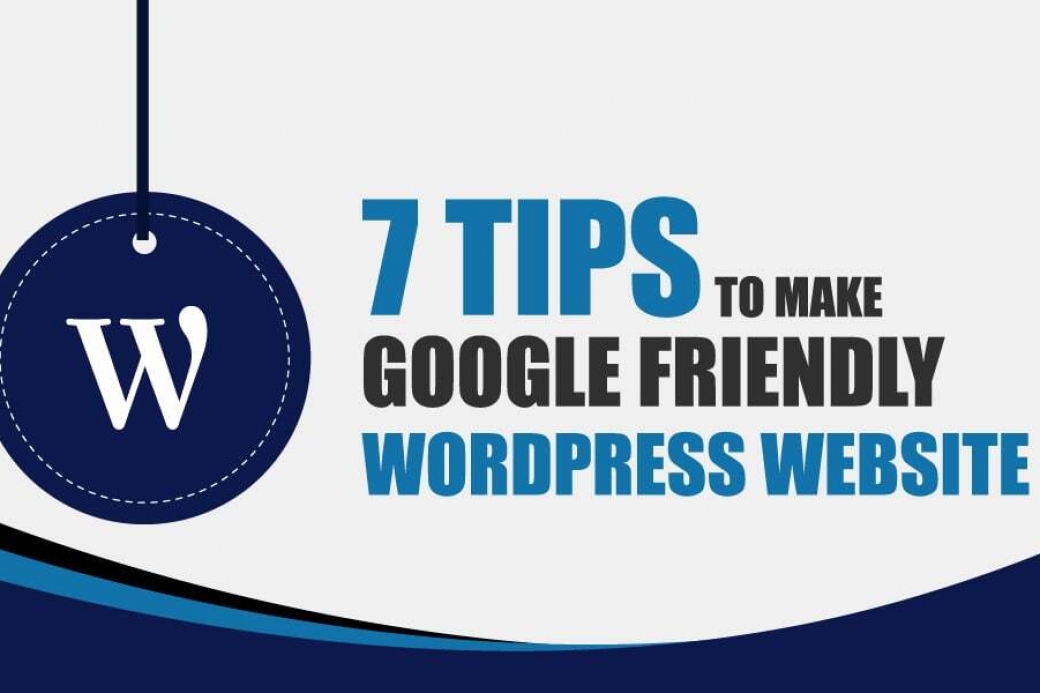7 Tips to Make Google Friendly WordPress Website

Google is everyone’s new best friend, especially for the millennials. They rely on Google Assistant to answer their everyday queries, Google Maps for navigating to a particular location, Google Drive for storing their unmissable documents, and Google Mail (Gmail) for what not!
On that note, the website owners pay extra heed to mark their presence on top of the search engine pages. To stay on top of the Google results is the whole game these days.
A user will most likely choose the first two or three links at the top of a query to get his desired answers. There are fewer chances that he might turn to page 2 or 3 in the hope of finding the correct answer to his query. If you as a website owner wish to be ranked on the first page, you will have to do the needful without delay.
The process of staying on top of the Google results must be done organically. But how can that be done in a seamless yet inexpensive manner? Here are seven such stellar tips to make a Google-friendly WordPress website in no time.
- Your Pages’ Loading Speed Is Your Achilles Heel
- SSL Encryption Is The Key
- Say No To The Broken Links
- Ensuring Your Website’s Mobile-friendliness
- Check The Meta Descriptions and Title Too
- Go Social Savvy
- Let The Images Do All The Talking
Check Out: Best WordPress Alternative SEO-friendly CMS
Your Pages’ Loading Speed Is Your Achilles Heel
Know that your customer base is mainly from the millennial zone. And it is a given that they run out of time and patience quickly. While it is not easy to catch the 'viewers' attention in this fast-paced world, you will have to ensure that your pages load as fast as possible without letting the viewer wait for the buffering to end.
Your content should be excellent; you might have put up quality pictures too; in fact, your infographic or embedded videos could be interesting also – but all that goes in vain if your page takes a few more time to load.
A customer will not wait forever and let the loading end. Instead, they will opt for another related site and do their business. You will find many such tools online that can tell you your exact speed and how to revamp that a bit more.
Google's algorithm is designed in such a manner to note which sites have the speed button and which not. And on similar tracks, it affects the ranking of your page on the search engines as well. Therefore, do not ignore this simple bullet; this could be your Achilles Heel.
SSL Encryption Is The Key
The millennial customer is almost always aware of questioning security in the digital domain. On that note, they do not wish to take any backseats when it comes to masking their vulnerabilities in any form.
They have begun to exercise this concern sooner than later while browsing online and look for the SSL Certificate as and when they land on a page. That is the magic behind the SSL encryptions. It enables the user to know that the site is safe to use and their communications are encrypted. It cannot be decrypted in simpler words until and unless it hasn't reached its final destination yet.
And how check SSL Certificate in browser? It is simple. Just look for the green padlock sign at the top of the URL. This signifies that the site is away from the cybercriminals' knuckles and that the HTTPS symbol is more like a trust indicator. Do not forget to get one of these as soon as possible and from a reliable source.
Say No To The Broken Links
To give your customers the best customer experience, your website must do well with the functional aspects. And broken links ruin this experience. Seeing a 'Page Not Found' status is not what a customer wants to see and causes sheer disappointment and frustration.
Seeing too many of these kinds of pages can trigger them to leave your business altogether. The second you find a broken link on any of your pages or a link that does not work correctly, make it a point to fix this issue at the earliest.
This is something that Google observes too. It can easily catch a site with several such broken links and can hamper your overall rankings on the search engine page.
That is why let your team conduct a sanity check on each of these links before they go live. Or, at best, prevent the broken links from appearing a little too many times on the screen.
Ensuring Your Website’s Mobile-friendliness
Like we just mentioned, the millennials today want to find all the information on their fingers' tips on their smartphones. While that might take a while to evade, it is of high pertinence that you design a mobile-friendly site in all ways.
That is why the website designers must account for this factor and design the website to run well on mobile screens. In simpler terms, the screen resolution should work equally well for both desktops and mobile phones.
Note that the Google algorithm is designed in a similar fashion that catches the sites that practice it well. Google offers a separate suite of utility tools to get a reality check whether or not your websites are working in a mobile-friendly manner or not.
Know that the chances of getting your pages browsed are higher on a mobile screen than that of a desktop screen. So, see that you do not lose out on a significant customer base due to the screen resolution facet at any cost.
Check The Meta Descriptions and Title Too
The meta description and your pages' title also have a significant role in ranking on a search engine page. These are some of the first things that a reader sees when browsing through several content pieces. That is when these facets decide whether the reader wants to dive in or not.
The actual length of a title should be somewhere around 60 characters. And the perfect size of the meta description should be around 150 to 160 characters at max. When you exceed these characters, it skips the chances of being positioned in the first few pages as per Google's algorithm.
That is why ensure that they stick to the character length and are also SEO-optimized. Ensure that both the title and the meta description have your keyword, and it should be clear to the reader from the starting what the page is all about.
Note that a well-written meta description increases your chances of being picked up more often than those which are not so well-written or absent. To double your chances and ensure an SEO-friendly site, pay more attention to these details as well.
Go Social Savvy
Does your website have its share of social presence? Are you active on the social front? Do your customers mention you and engage with you actively on social media? It has been found that Google too prioritizes the websites that link to the social media platforms.
Your website ought to be designed so that it can be easily shared on social media to increase its reach. Know that you will always get a more significant fan and follower base from social channels. Make it a point to hold with your customers as often as you can. Respond to their needs and queries too. Congratulate when you see a positive review or comment.
And reach out to them personally if you see that they had a tiff in any manner or are disappointed in your product. A customer carries a big impression from how well you behave around in the social front, so make the most of it and shine bright. Most of the millennial customers are active on Facebook, Instagram, and Twitter.
That is why there is no better way to make your products shine. Also, keep an edge on such platforms by being active as often as possible. Google notices these engagement quotients and allows those who are active to rank better on the search engines.
Let The Images Do All The Talking
Gone are the days when text-heavy content was in need. Now the millennial customers do not want to land on a page that is so full of text that it seems too cluttered. This is something that is not even Google-friendly too. So what do you do then? Say yes to the imagery.
Yes, you read that right. Sometimes, the imagery holds pivotal value and can convey more information in less time than a chunk of text. While you do that, make sure that you do not put up poor-quality or non-HD pictures across your webpages. That is a big no-no and can put off a customer.
The images should not only be appropriate, but they should be relatable and higher in resolution too. Note that it is your images that a customer relies on before hitting on the 'Buy Now' button. So, ensure that these images are engineered to make the sale.
On similar tracks, Google's algorithm also has a way around with the pages with a higher quality image over the poor ones. Clubbing your content with creative infographics and videos can also add a dollop of pizazz onto your text. This can be a big crowd-puller too.
That’s A Wrap
A legit website is critical to a business's ratings in their respective niches. That is when the Google rankings also reflect the same. While you can always take to the modern tools and technologies that will allow you to be on the top of your game, but at the same time, you must know the mere basics too.
Some of these include perfect formatting and pagination, keeping the content highly relatable and accurate, with zero broken links and quality images or graphics elements to the club along.
And each of these methods can be incorporated by well-executed planning alone; you will not have to burn your wallet for these to occur. Whatever it is, you will always need a good blend of dedication and perseverance to let things work in the direction you wish to.
Make it a point to acknowledge the fact that there is always more room for improvement. Start with following these seven tips, and you will soon start to see concrete results in no time.
Would you like to check: Top 15 PHP Blogging Platforms and Content Management System











